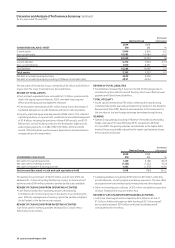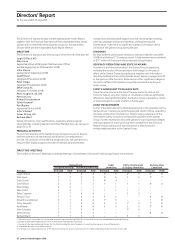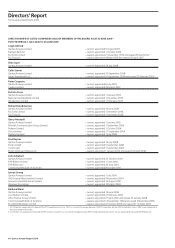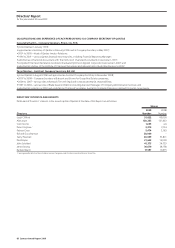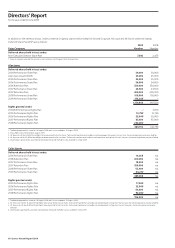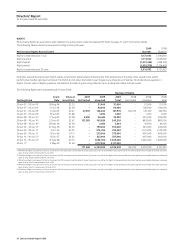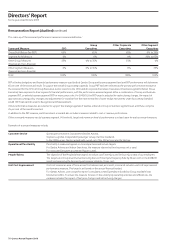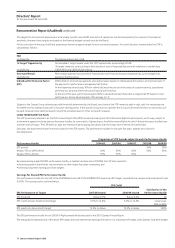Qantas 2009 Annual Report Download - page 70
Download and view the complete annual report
Please find page 70 of the 2009 Qantas annual report below. You can navigate through the pages in the report by either clicking on the pages listed below, or by using the keyword search tool below to find specific information within the annual report.
68 Qantas Annual Report 2009
Directors’ Report
for the year ended 30 June 2009
The Remuneration Report sets out the Executive Remuneration Framework
at Qantas and discloses the remuneration of Directors and Disclosed
Executives (includes Key Management Personnel and Highest
Remunerated Executives).
EXECUTIVE REMUNERATION PHILOSOPHY AND OBJECTIVES
Executive pay is set competitively, based on the size and nature of the role
(with reference to market benchmarks) and the performance of the
individual in the role. The objectives of the Executive Remuneration
Philosophy are to:
•attract,retainandappropriatelyrewardacapableExecutiveteam;
•motivatetheExecutiveteamtomeettheuniquechallengesitfacesasa
majorinternationalairlinebasedinAustralia;and
•linkpaytoperformance.
Remuneration includes an ‘at risk’ element for which the objectives are to:
•linkExecutiverewardwithQantas’businessobjectivesandfinancial
performance;
•aligntheinterestsofExecutiveswithshareholders;and
•supportacultureofemployeeshareownershipandtheretentionof
participating Executives.
ROLE OF THE REMUNERATION COMMIT TEE
The Remuneration Committee (a committee of the Board) has the role of
reviewing and making recommendations on all elements of Executive
Remuneration at Qantas to ensure they are appropriate from the
perspectives of governance, disclosure, reward levels and market
conditions.
In fulfilling its role, the Remuneration Committee is specifically concerned
with ensuring that its approach will:
•motivatetheCEO,CFOandExecutiveManagementtopursuethelong-
termgrowthandsuccessofQantas;
•demonstrateaclearrelationshipbetweenperformanceand
remuneration;
•ensureanappropriatebalancebetween‘fixed’and‘atrisk’
remuneration,reflectingtheshortandlong-termperformanceobjectives
ofQantas;and
•differentiatebetweenhigherandlowerperformersthroughtheuseofa
performance management framework.
The Remuneration Committee considers advice from a range of
independent external advisors in performing its role. The principal advisors
referred to are PricewaterhouseCoopers, Ernst & Young and the Hay Group.
THE REMUNERATION FRAMEWORK
During 2009, the Remuneration Committee performed an extensive
review of the Remuneration Framework. In June 2009, the Remuneration
Committee recommended and the Board approved a change to the
framework. A new annual incentive, the Short Term Incentive Plan (STIP), is
being introduced for the 2009/10 performance year. The STIP replaces the
Performance Cash Plan (PCP) and the Performance Share Plan (PSP) which
operated in 2008/09 and have been discontinued from 30 June 2009.
The operation of the PCP and PSP are detailed on pages 72 and 73.
The Long Term Incentive Plan (LTIP) was previously referred to as the
Performance Rights Plan.
The Remuneration Framework comprises:
Fixed Annual Remuneration (FAR) Set based on the scope of the role and performance of the individual.
Short Term Incentive Plan (STIP) Performance assessed against a scorecard of measures:
•Protbeforetax(PBT);
•Unitcost;
•Non-nancialmeasures.
Long Term Incentive Plan (LTIP) Performance Rights are awarded, with vesting determined by performance
against three year financial targets:
•TotalShareholderReturn(TSR)vsS&P/ASX100index;
•EarningsPerShare(EPS)performance.
TARGET MIX OF REWARD COMPONENTS
The proportion of remuneration attributable to ‘fixed’ pay and ‘at risk’ pay (STIP and LTIP) is dependent on the level of responsibility of the Executive. The
target reward mix is:
% of Total Reward Opportunity (‘at target’)
FAR STIP LTIP
ChiefExecutiveOfcer 35% 45% 20%
ChiefFinancialOfcer 45% 40% 15%
GroupExecutives 50% 35% 15%
OtherExecutives 60–85% 15–30% 0–10%
Remuneration Report (Audited)



